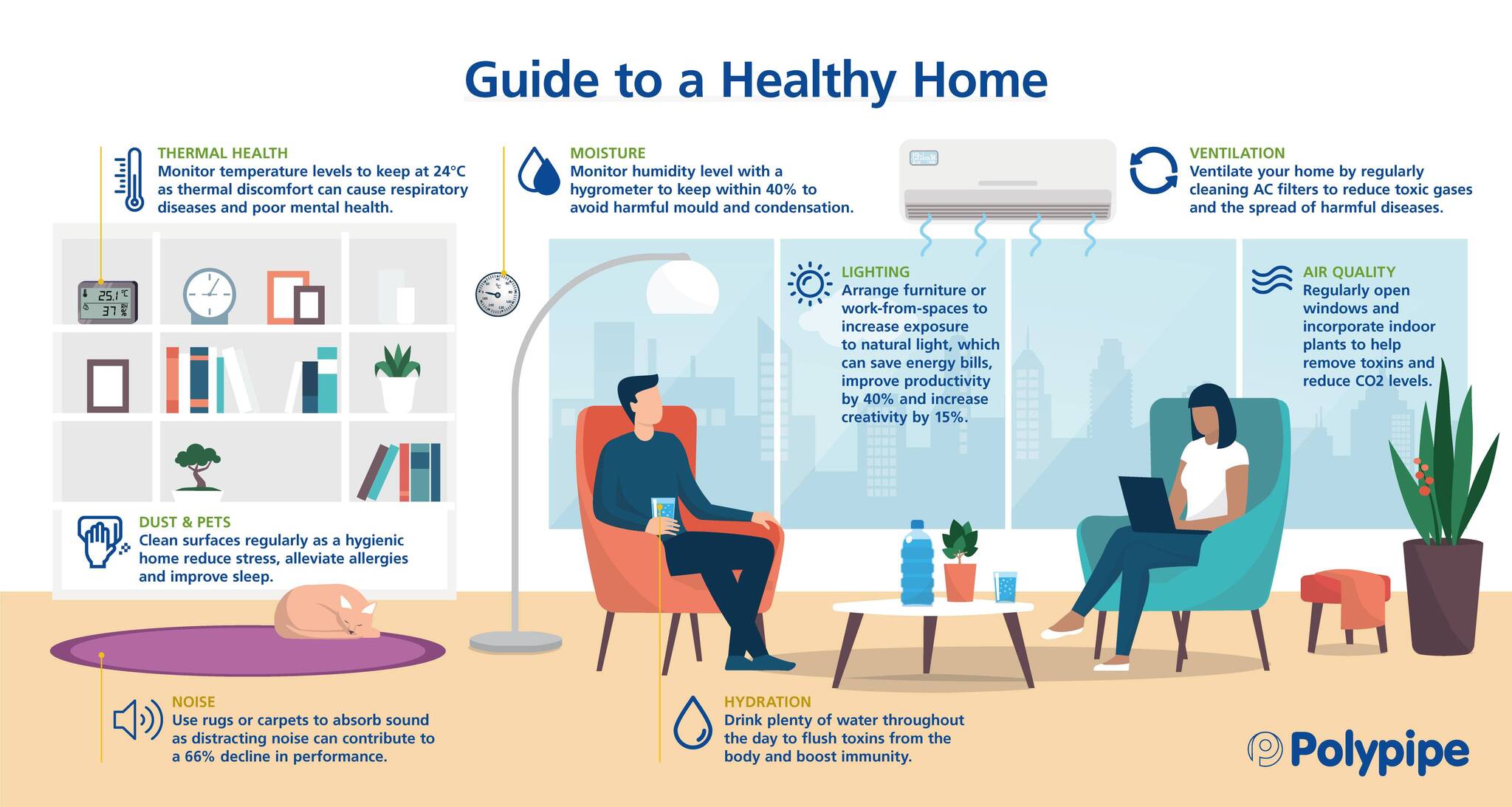How to Ensure a Healthy Home
Monday 13th April 2020

A healthy building can be defined as a space that supports the physical, psychological and social wellbeing of occupants so they can operate at their highest functionality.
With the growing global adoption of green building standards such as LEED and WELL, there is undoubtedly an increasing awareness surrounding the key elements needed to better support health and wellbeing in our spaces.
In light of current events, our daily routines are changing. More and more people are having to stay at home and adapt their spaces to better work, learn, live and relax. This shift can have a powerful impact on health and wellbeing.
Especially now, it is important for us to realise the complex link between our homes and our health. Our home environments can actually have a profound influence on our health and wellbeing. That’s why we are exploring 5 features necessary to creating safe and healthy indoor environments that unlock many benefits for you and your loved ones.
Better Breathing
Over half of the air you’ll breathe in your lifetime will be inside your home.
Therefore, air quality, both indoor and outdoor, play an essential role in human health and wellbeing. In fact, studies have found that the concentration of indoor air pollutants can actually be two to five times higher than in outdoor environments!
Creating a healthy indoor air quality starts at the beginning. Specialised drainage solutions, engineered specifically for high-rise use, should be considered and integrated into the design and build stage. These allow for better ventilation, eliminating foul odours and leaks in buildings. According to the WHO, ensuring safe and reliable drainage systems is “a simple public health measure which is often overlooked but can be addressed at minimal extra cost.” These systems can act as significant tool in reducing the transmission of infectious diseases.[i]
When it comes to our homes, maintaining a healthy indoor air quality also helps to reduce illnesses caused by poor ventilation and toxic gas leaks.
Cleaning AC filters regularly, or simply opening your windows, also helps to improve ventilation and enhance indoor air quality.
Another green way to improve air quality in our homes is through indoor plants. Research by NASA revealed that certain houseplants can improve air quality by removing 87% of toxins in just 24 hours. Adding natural elements into the home also helps us feel connected to nature, which reduces stress and makes us feel happy and healthy.
Learn more about the benefits of maintaining healthy indoor air quality.
Brighter Living
Introducing natural daylight into our spaces can be extremely beneficial for our mood, health and wellbeing.
Exposure to natural daylight helps to reduce stress and elevate mood, creating happier, healthier environments for occupants.
Consider arranging work-from-home spaces with plenty of access to natural daylight, which can increase productivity by 40% and creativity by 15%. Furthermore, it can help regulate circadian rhythms and increase sleep, so people feel better rested and ready to work.
15-30 mins of daily exposure to sunlight, even if it’s just on your balcony, roof or garden, can provide the body with its daily dose of vitamin D, which is effective at boosting immunity.
Not to mention, increased natural daylight can save energy. Did you know that around 20% of our electricity bill can be accredited to lighting? Increased daylight can reduce the need for artificial light by 16-20%.
The Ideal Temperature
Thermal comfort is described as “the condition of mind that expresses satisfaction with the thermal environment.” In other words, feeling comfortable with the temperature of your environment.
This is an important, often underestimated, factor in determining productivity and wellbeing.
Thermal discomfort can cause stress for human beings. For example, if it’s too warm, this can make us feel tired and unproductive. Whereas if it’s too cold, we start to feel restless and distracted. This is why achieving the optimal temperature is especially important now when many people are adjusting to working from home.
Furthermore, thermal discomfort is associated with a number of health problems such as respiratory illnesses, asthma and poor mental health.
However, thermal comfort comes down to more than just temperature. It’s about striking the right balance between air temperature, humidity and airflow, to create the optimal environment. Furthermore, thermal comfort “zones” may vary between individuals.
For most people, the recommended temperature to create a comfortable environment, as recommended by DEWA, is 24 °C [ii], with a humidity level of around 40%. Occupants can use a hygrometer to monitor humidity levels.
But it’s not just up to the occupant. Buildings constructed with well-sealed coverings are more airtight, helping occupants to maintain the environment they have created in their homes.
Noise-Free Environments
We’ve all had experiences with unbearably distracting noises! But did you know that distracting noise can contribute to a 60% decline in performance?
When working from home, noise pollution can be particularly unnerving. Furthermore, long-term exposure to noise pollution can exacerbate a range of health problems such as stress, high blood pressure, hypertension and strokes.
When staying at home, the goal is to create an environment conducive to focus and concentration.
Once again, this starts with the design and construction of a building. A well-sealed building covering can reduce noise penetrating into the building. In addition, incorporating proper drainage that goes “unnoticed” will ensure that no distracting noises (or odours!) are being caused by the drainage systems.
It’s true that it can be challenging to control the noise produced outdoors but we can control the effect of this noise in our homes. A tip is incorporating carpets or rugs in areas of the home with amplified acoustics.
Dust and Pets
Keeping a clean and hygienic environment is vital to our health and wellbeing. Particularly in the Middle East, dust collects extensively and rapidly in our homes.
When dust accumulates, it acts as a reservoir for chemicals, allergens and metals. Therefore, cleaning regularly to reduce dust and animal dander is especially important to support the health of those who suffer from asthma or allergies.
Using high efficiency filter vacuums can help to limit dust and dirt accumulation. Even simply taking shoes off at the door can reduce the amount of dirt tracked into the living space.
While you should be wary of using pesticides or cleaning products high in volatile organic compounds (certain chemical that can be harmful when inhaled), it is still important to take preventative measures to ensure a clean home and avoid moisture build-up such as regularly removing trash and managing pests.
Water Quality
Water is integral to human life. From hydrating our bodies to washing our clothes, water plays an irreplaceable role in our home life.
Therefore, it is important that we take precautionary measures to ensure the quality of the water we use. We can test water regularly to determine contaminants and also ‘hardness’, as this can have varying effects on our bodies and our appliances.
Furthermore, we can install water purifications systems at home to remove contaminants and purify the water used for bathing, cooking and drinking.
Speaking of water, let’s all remember during this time to stay hydrated! Staying sufficiently hydrated helps to flush toxins from the body and maintain a healthy immune system.
With all that in mind, here’s a quick guide to ensuring a healthy home:
Why are Healthy Buildings More Important than Ever?
Essentially, our homes and buildings are an important part of a holistic ecosystem that is the built environment.
We spend approximately 90% of our time indoors. And given the extraordinary situation we are facing, it’s possible that this figure is currently even higher!
Therefore, there’s no better time than the present to delve deep into our buildings and ensure we are optimising our homes to create happier, healthier environments that support health and wellbeing.
At Polypipe Middle East, we are dedicated to helping create more resilient cities. We understand that a vital part of this is supporting the creation of healthier buildings. As pioneers in our field, we have the expertise to make this happen.
During this time, we are dedicated to supporting your health and wellbeing. Contact us to discover how we can contribute:
Tel: +971 (0) 4 518 3000
Email: middleeast@polypipe.com
[i] https://www.who.int/mediacentre/news/releases/2003/pr70/en/
[ii] https://www.dewa.gov.ae/en/about-us/sustainability/lets-make-this-summer-green/24-degrees-campaign

